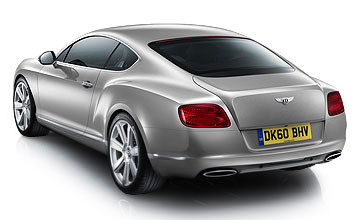BY JACQUI MADELIN | 13th May 2011

The stronger, more sculpted look with its streamlined creases emphasised by the greater width make a visual promise this car wasn’t quite nimble enough to deliver on the steep climb.
But once into the more open, sinuous bends carving the wind-blasted grasslands up top we discovered a far more engaging beast than this car’s predecessor.
The greater rear bias was immediately noticeable. Powering out of bends, the nose tucks in as the mighty haunches drive you out, the car transmitting just enough road feel to keep you connected with what’s going on beneath it.
Changes to the electronically adjustable suspension proved particularly effective, the Sport setting tightening response at acceptable cost to comfort, and the softer extreme on this sliding scale able to iron out speed humps (yes we tried) yet still capable of holding the GT steady through a set of bends, albeit with a slightly springier ride.
We found one setting below Sport the best compromise and left it there.
The ageing W12 engine has held up well and the car still delivers a rich, rolling soundtrack best appreciated from the pavement, its note recalling vintage speed-boats – and suggesting a modern diesel could work, given that format’s basso beat.
Meanwhile, this now more powerful 423kW/700Nm W12 still makes light work of punting the 2320kg body along, speed picking up with such deceptive ease that when combined with the GT’s rock-solid high-speed stability we were often tricked into misreading the mph speedo as kilometres – this UK-spec car is the only one in the southern hemisphere pending the imminent arrival of Australian versions.
Yet cornering attitude is impressive too, the GT’s massive grip and sensitive steering letting you place it accurately, adjusting it on the throttle as you haul from one apex to another.
Driving like this didn’t do much for the car’s thirst. The claimed 16.5L/100km lifted to 21.7 over the course of our drive.
Such a spirited approach also revealed a shortcoming in the seat support. Bentley says owners wanted less shape at the shoulder and more at the waist, and these pews certainly look good. We especially like the adjustable seat squab that does away with the more usual expanding or contracting crumb-catcher ‘crease’ line, instead using a system that tightens and ‘rolls’ the seat front down and under. It’s a neat trick that works well.
However, drivers built like myself and my (male) co-driver would like to see the adjustable side bolsters increasingly common in top-end cars with sporting aspirations.
There were no complaints from the rear, though. While the back seats remain a tad cramped there is more space back there than before, while the boot remains 358 litres – interior designer Robin Page said customer feedback suggested that’s sufficient.
Now in cruising mode, we tried the eight-inch touch-screen that accesses a 30GB hard drive to link our iPod – yes, the Naim audio created for this car is impressive – and to scroll through a few sample functions.
Interior designer Robin Page admits new technology is a nightmare for designers. “Technology keeps changing and the automotive world is usually behind. Into the future it’s about being able to download the new tech and for Bentley it’s about integrating it without turning it into an everyday car.”
The need to integrate new technology yet have it ‘talk’ to the rest of the car is a problem that affects the industry as a whole.
“There’s a danger with technology that it can date the car,” Mr Page says. “So the Mulsanne has a drawer big enough to take most devices you plug it in or connect via Bluetooth, close the drawer and forget it.”
There’s no such drawer in the GT but there is more storage space, including door pockets, centre cubbies, and an ingenious cup-holder that will hold a removable ashtray – or accommodate an integrated sunglasses holder (apparently filched by a previous driver) finished in matching wood, which pops out should you wish to take it when you leave the car.
We also like the ability of that carbon rear spoiler – painted black to seamlessly integrate with the window surround – to disappear into the window surround or lift up, at around 193km/h or at the touch of a button.
But the best indicator of Bentley’s ability to effortlessly blend classic and modern is the Breitling analogue clock that sits as a final flourish against the polished heartwood dash.
Designed in conjunction with, and signed off by, the traditional watch supplier, it’s nevertheless built by Paragon. According to Mr Page, this is because “it has to communicate with the rest of the car”.
“So if you set the time in front of you it’ll reset the car’s timing as well.”